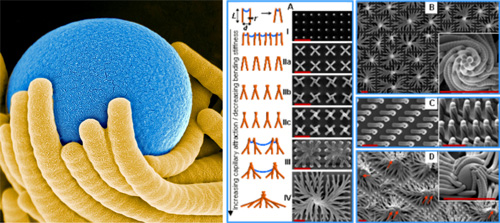New Ordered Hierarchical Helical Assemblies

Left: Figure that appeared in the NY Times (courtesy of J. Aizenberg) and is taken from our study that was published recently by B. Poakroy, S. Kang, L. Mahadevan and J. Aizenberg, Self-organization of a meso-scale bristle into ordered hierarchical helical assemblies, Science 323, 237, 2009.
Right: Schematic diagrams (left) and corresponding SEM images (right) showing the morphogenesis of chiral patterns from the first-order unclustered nanobristle to the fourth-order helical bundle. (A) Schematic diagrams (left) and corresponding SEM images (right) showing the morphogenesis of chiral patterns from the first-order unclustered nanobristle to the fourth-order helical bundle. Note the hierarchical nature of the assembly reflected in the presence of the lower-order braids in the large clusters coiled in a unique structure reminiscent of mythical Medusa. (B) SEM of an array of high-order helical clusters. Inset: magnified view of the helical core. (C) Top (left) and angled (right) views showing an array of ordered helical pairs with uniform handedness. (D) Particle trapping (indicated by arrows) in the assembled bristle. Inset: magnified view of a captured particle. Scale bars: 4 µm.
Mesoscale hierarchical helical structures with diverse functions are abundant in nature. Aizenberg, Mahadevan, and their coworkers have shown how spontaneous helicity can be induced in a synthetic polymeric nanobristle assembling in an evaporating liquid, consistent with a theoretical model to characterize the geometry, stiffness, and surface properties of the pillars that favor the adhesive self-organization of bundles with pillars wound around each other. The process can be controlled to yield highly ordered helical clusters with a unique structural hierarchy that arises from the sequential assembly of self-similar coiled building blocks over multiple length scales. The MRSEC team has also demonstrated their function in the context of self-assembly into structures with uniform, periodic patterns and controlled handedness with the potential to create reversible adhesives, mechanical memories and active microscale mixers and stirrers.
David A. Weitz (Physics & Applied Physics)
Cynthia M. Friend (SEAS)
Boaz Pokroy,
Sung H. Kang,
Lakshminarayanan Mahadevan (OEB, Physics, SEAS), and
Joanna Aizenberg (Chemistry and Material Science)
Harvard MRSEC (DMR-0820484)
